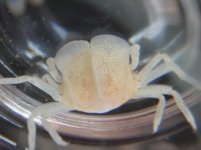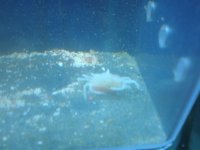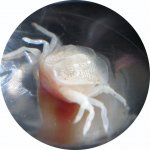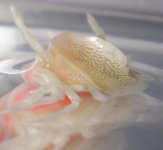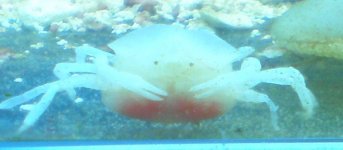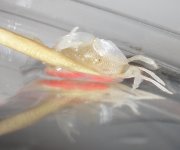Hello again Leslie,
Well.. to answer your question..
Not exactly!
I will include some of the e-mails I've gotten but not flood you with all.
There was even a man in New Zealand that wanted to have it to study if I did not want to keep it.
Once the crab was separated and only fed dark food the red in the belly changed to brown. So, I take it .. not eggs.
He/she is growing and getting whiter. Nothing else has changed other than a bit less timid.
Still have not released it into the normal tank but, we are on the verge of it as I am getting tired of the breeder tank in there and the troubles of keeping it algae free.
Since I am not sure what it is or what damage it possibly can do even tho I have no clam type's in there at the moment..doesn't mean I won't want to add some and then I will be wondering.. will the crab kill it.
So.. we are still tossed.. finding it in the rocks would be next to impossible once I release it.
Husband wants to just toss it to be on the safe side. I'm wanting to just release it.. LOL So.. the Breeder tank it is.
I was just thinking about the forum today and going to post a note of 'still not sure'.
Thank you for thinkin about us.
Beth
Dear Beth LeBlanc,
Thank you fur your inquiry. On the basis of the pictures provided I can
only give an intelligent guess:
I think the crab is Nursia or Paranursia (both leucosiids). If so, it
will be from somewhere in the Indopacific ocean. Please give me the
details of the page where I can see more pictures and I will try to do
my best to specify my "intelligent guess"
Best wishes
Michael Tuerkay
Hi Beth,
Your crab is a species of Durckheimia, but I'll need to see more images before I can give a more complete identification. It's a very interesting genus of pea crabs which uniquely has the very thin longitudinal crest on the carapace. They are very rarely seen (though probably common) and usually live inside species of Limidae - so if you had a flame scallop or file shell in your tank, it probably came from there. Do you know what host it came from?
If you are not planning to keep it, I would be very interested to study the specimen since these are not often seen. In any case, it would be very good if you could take some good photo's - I'm certainly interested to see the other images you have on snapfish. Attached is a recent paper figuring the species of Durckheimia as well as species that live inside giant clams.
Let me know if you need any further help.
Cheers,
Shane.
Hi Beth LeBlanc,
I think it's probably a pinnotherid, too, but the photographs are not
particularly helpful for identification. There are other commensals,
particularly a few portunids from sea cucumbers and sea anemones, but the
fifth, or last, leg is not paddle-shaped as in most of the portunids. Did
it just occur in your tank or do you have other inverts in the tank? Do you
have clams or other bivalves in the system? Pinnotherids are often found in
mussels and oysters. I've got at least two recipes for them somewhere, and
I've even eaten them. They can be eaten whole (after cooking) because their
shell is soft.

All pinnotherids are commensals and I suspect it came
in inside of something. I agree with Dr. Ron Shimek's comments.
I don't think it's a leucosid, but the photos are not of high enough
quality to tell. Is it a tropical or temperate tank? Can you get a better
picture of the dorsal or top of the crab?
Jeff
Hi Beth,
I finally received a response from our aquarists about the crab images you sent us. We have also asked for some feedback from another member of our staff but haven’t heard anything back yet.
Here is the response I have received so far.
Hi Dawn,
I quickly looked at it and my first comment is that I don’t know what it is! It sounds like a tropical crab and not knowing the history but reading between the lines makes me think this person has it in a tropical saltwater aquarium? Lee also quickly looked at it and had no idea but he said he isn’t an expert on tropical crabs. It sort of looks like small pea crabs that we have around here that often live inside clams but if it ate this person’s scallop then maybe not that type of crab? The carapace shape looks different and almost makes me think it could be a newly settled juvenile of whatever species it is? I will send images to Tak who has more experience with tropical species to see if he can figure it out. If this person is really eager to identify it they could try sending the images to a friend and colleague from the University of Washington Dr. Greg Jensen who specializes in crustaceans?
Regards,
Dawn Bassett
Manager, Content and Information Resources
Robin Best Library
Vancouver Aquarium
PO Box 3232 Vancouver, BC
V6B 3X8
604.659.3404
Hi again Beth,
One of our other animal people sent along the following.
I think I found it.
It's Durckheimia caeca .
I don't know its common name but this species seems known lives in flame scallop.
I could not find photo on the net but found it on my book.
Tak
Cheers!
Hi
it looks like Durckheimia caeca- a female with eggs. A very unusual kind
of pea crab, as most have a smoothly rounded carapace.
Greg




